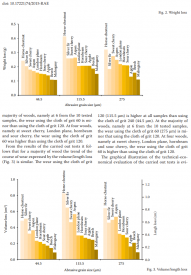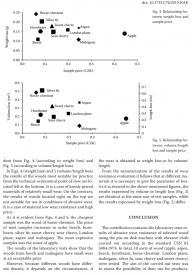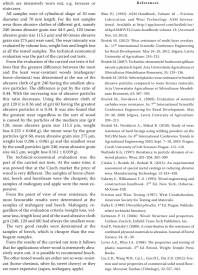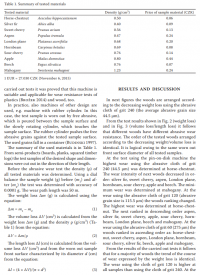Wood is a natural material, which our ancestors had learned to utilize very early. The first use of wood was evidently energy utilization with the aim to gain heat by its combustion. Later, wood has been utilized to construction of buildings and fortifications, building of means of transport (ships and wagons) and tools.
In contrast to other used materials (metals, plastics, aggregate, limestone, glass, ceramics, …) wood has one exceptional property – it is a renewable material. From statistical sources it follows that in the long term the one-year wood growth in the Czech Republic is higher than logging. Hence, the wood supplies increase.
Compared to other materials the properties of wood are different (Kafka 1989; Pluha? et al. 1989;Peschel 2002; Kettunen 2006). Some differences can be seen at first sight, e.g., colour, gleam or texture. In contrast to many other materials wood has a specific aroma. From physical properties, let us specify e.g. density, moisture (shrinkage, swelling) and thermal, electric and acoustic properties. From mechanical properties let us specify at least elasticity, strength (tensile, pressure, bending, shear,torsion), hardness, toughness. Technological properties of wood are also exceptional, e.g. machinability, bendability, loading capacity of metallic binders, wear resistance or various defects. For some applications, e.g. floors and staircases, the wear resistance is very important (Ohtani et al. 2001,2002, 2003; Král, Hrázsk? 2008; Liu et al. 2012)(Czech National Standards: ?SN 01 5050:1969;?SN 49 0134:1984; ?SN EN 13696:2009; ?SN 910276:1989).
Today, wood is still considered as a very good building material. The greatest consumer of wood is therefore building industry, followed by cellulosic-paper industry (Tsoumis 1991; Faherty,Williamson 1995; Zahradní?ek, Horák 2007;Slavid 2009). Production of furniture, musical instruments, works of art, sports equipment or of toys for children represents an interesting utilization of wood. A part of wood is consumed in the form of firewood.
In the contribution, the results of abrasive wear resistance study of 10 sorts of wood (apple, aspen,beech, hornbeam, horse-chestnut, London plane,mahogany, silver fir, sour cherry and sweet cherry) are published. The laboratory tests were carried out using the pin-on-disk machine with abrasive cloth,when the abrasive clothes of 3 different grits (240,120 and 60) were used. The wear intensity of all test samples was assessed by volume, weight and length losses at different conditions.
The part of the carried out tests was the technicaleconomical evaluation, too. The prices of wood used in calculations are the average prices in the Czech Republic calculated from the offer of 13 sellers.
MATERIAL AND METHODS
For the materials, wear resistance determination of single wear types (?SN 01 5050:1969) in principle field tests, pilot tests and laboratory tests are used.Each of the mentioned tests has advantages as well as disadvantages. Therefore, each of the test types is suitable for another field of application. The wear resistance test type is always necessary to be chosen with regard to the in-wear process dominant conditions and to the demanded test results (Bro?ek 2007).The wear intensity can be expressed by the directly measured values or by the relative values.The directly measured value can be abrasion specified in length (cm), weight (g) or volume (cm3). The other possible way is to express the dimensionless quantity, when wear intensity of the tested sample is compared to the wear intensity of the standard(Vocel, Dufek et al. 1976; Vocel 1983).
In literature, a sufficient number of wear resistance testers for various types of wear is mentioned (Lever, Rhys 1968; Vocel 1983; Friction and Wear Testing 1987; Blau 1992). Testing equipment for abrasive wear resistance determination is usually classified according to the contact mode of the sample with free or bonded abrasives. In practice, the testing machines with abrasives bonded to cloth (Fig. 1) are used most often. They are simple and reliable, with small variance in results. Their disadvantage is the variable quality of abrasive cloth. In the Czech Republic this testing method is standardised according to ?SN 01 5084:1974 (similar foreign standards: STN 01 5084, ASTM G 132).The principle of the abrasive wear test using the pin-on-disk machine with abrasive cloth (?SN 01 5084:1974; Fig. 1) is to wear the sample under predetermined conditions. Using the apparatus with abrasive cloth the samples were of 10 mm diameter and 70 mm length. The test sample was pressed against the abrasive surface using the prescribed normal force. The wear path was a spiral on the disk, caused by the disk rotation and the radial feed of the sample, so the sample progressively moved over the unused abrasive along the prescribed track length.
As abrasive cloth the corundum twill type A 99 – G, S 25, trademark Globus, grit 120, was used. In addition tests using grits 60 and 240 were carried out, too. It corresponds to the average abrasive grain sizes of 44.5 (grit 240), 115.5 (grit 120)and 275 ?m (grit 60) (Bro?ek et al. 2010). During the test, the test sample was pressed to the abrasive cloth by the pressure of 0.1 MPa.
The above-mentioned pin-on-disk machine with abrasive cloth (bonded abrasive) is primarily destined for the determination of abrasive wear resistance of metallic materials (Bro?ek, Nováková 2008; Bro?ek 2012; Cieslar et al. 2013). By the carried out tests it was proved that this machine is suitable and applicable for wear resistance tests of plastics (Bro?ek 2014) and wood, too



